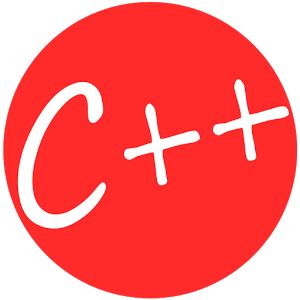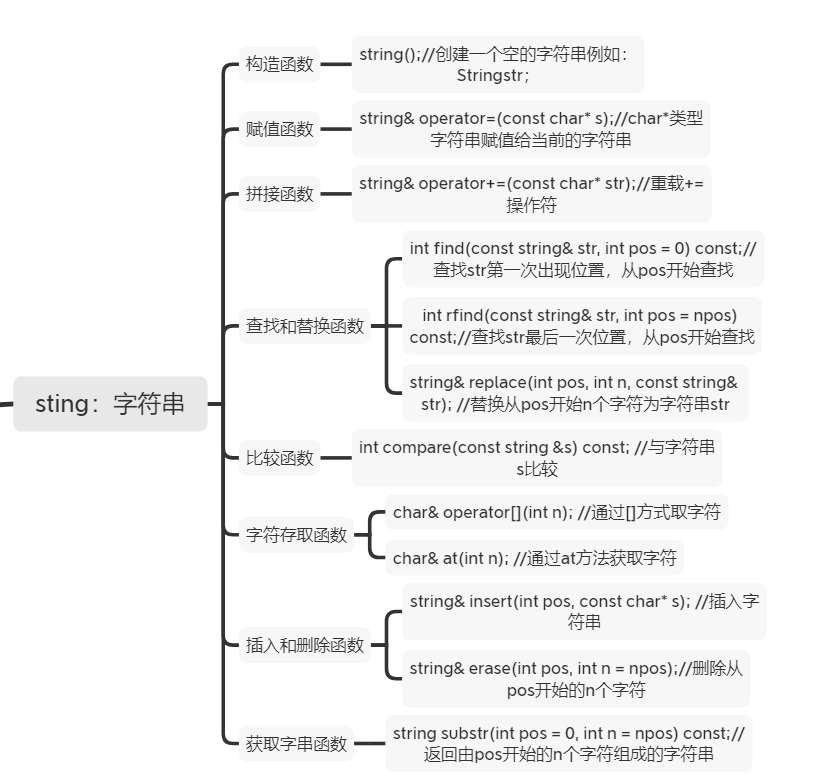
3.1、string–字符串容器

3.1.1、字符串基本概念本质:
字符串是C++风格的字符串,字符串本质上是一个类
字符串和char*区别:
char*是一个指针
字符串是一个类,类内部封装了 char* ,管理这个字符串,是一个char*型的容器。
特点:
字符串类内部封装了很多成员方法;
例如:查找查找,拷贝复制,删除删除替换替换,插入插入;
字符串管理char*所分配的内存,不用担心复制越界和取值越界等,由类内部进行负责。
3.1.2字符串构造函数
构造函数原型:
string();//创建一个空的字符串例如:Stringstr;string(const char* s);//使用字符串s初始化
string(const string& str);//使用一个字符串对象初始化另一个字符串对象
string(int n, char c);//使用n个字符c初始化
示例:
1
2
3
4
5
6
7
8
9
10
11
12
13
14
15
16
17
18
19
20
21
22
23
24
25
26
27
28
29
| #include <iostream>
#include <string>
using namespace std;
void test01()
{
string s1;
cout << "str1 = " << s1 << endl;
const char* str = "hello world!";
string s2(str);
cout << "str2 = " << s2 << endl;
string s3(s2);
cout << "str3 = " << s3 << endl;
string s4(10, 'a');
cout << "str3 = " << s3 << endl;
}
int main() {
test01();
system("pause");
return 0;
}
|
输出:
1
2
3
4
| str1 =
str2 = hello world!
str3 = hello world!
str3 = hello world!
|
注:在使用sting容器时,要包含库文件:#include
3.1.3字符串赋值操作
功能描述:
赋值的函数原型:
string& operator=(const char* s);//char*类型字符串赋值给当前的字符串string& operator=(const string &s);//把字符串s赋给当前的字符串string& operator=(char c);//字符赋值给当前的字符串string& assign(const char *s);//把字符串s赋给当前的字符串string& assign(const char *s, int n);//把字符串s的前n个字符赋给当前的字符串string& assign(const string &s);//把字符串s赋给当前字符串string& assign(int n, char c);//用n个字符c赋给当前字符串
示例:
1
2
3
4
5
6
7
8
9
10
11
12
13
14
15
16
17
18
19
20
21
22
23
24
25
26
27
28
29
30
31
32
33
34
35
36
37
38
39
40
41
42
43
44
45
46
| #include <iostream>
#include <string>
using namespace std;
//赋值
void test01()
{
string str1;
str1 = "hello world";
cout << "str1 = " << str1 << endl;
string str2;
str2 = str1;
cout << "str2 = " << str2 << endl;
//字符赋值给当前的字符串
string str3;
str3 = 'a';
cout << "str3 = " << str3 << endl;
string str4;
str4.assign("hello c++");
cout << "str4 = " << str4 << endl;
string str5;
str5.assign("hello c++",5);
cout << "str5 = " << str5 << endl;
//把字符串s赋给当前字符串
string str6;
str6.assign(str5);
cout << "str6 = " << str6 << endl;
//用n个字符c赋给当前字符串
string str7;
str7.assign(5, 'x');
cout << "str7 = " << str7 << endl;
}
int main() {
test01();
system("pause");
return 0;
}
|
输出:
1
2
3
4
5
6
7
| str1 = hello world
str2 = hello world
str3 = a
str4 = hello c++
str5 = hello
str6 = hello
str7 = xxxxx
|
3.1.4字符串拼接
功能描述:
函数原型:
string& operator+=(const char* str);//重载+=操作符string& operator+=(const char c);//重载+=操作符string& operator+=(const string& str);//重载+=操作符string& append(const char *s); //把字符串s连接到当前字符串结尾string& append(const char *s, int n);//把字符串s的前n个字符连接到当前字符串结尾string& append(const string &s);//同运算符+=(ConstString&str)string& append(const string &s, int pos, int n);//字符串s中从pos开始的n个字符连接到字符串结尾
示例:
1
2
3
4
5
6
7
8
9
10
11
12
13
14
15
16
17
18
19
20
21
22
23
24
25
26
27
28
29
30
31
32
33
34
35
36
37
| #include <iostream>
#include <string>
using namespace std;
//字符串拼接
void test01()
{
string str1 = "我";
//重载+=操作符
str1 += "爱玩游戏";
cout << "str1 = " << str1 << endl;
str1 += ':';
cout << "str1 = " << str1 << endl;
string str2 = "LOL DNF";
str1 += str2;
cout << "str1 = " << str1 << endl;
string str3 = "I";
str3.append(" love ");
str3.append("game abcde", 4);
//str3.append(str2);
str3.append(str2, 4, 3); // 从下标4位置开始 ,截取3个字符,拼接到字符串末尾
cout << "str3 = " << str3 << endl;
}
int main() {
test01();
system("pause");
return 0;
}
|
3.1.5字符串查找和替换
功能描述:
- 查找:查找指定字符串是否存在
- 替换:在指定的位置替换字符串
函数原型:
int find(const string& str, int pos = 0) const;//查找str第一次出现位置,从pos开始查找int find(const char* s, int pos = 0) const; //查找的第一次出现位置,从pos开始查找int find(const char* s, int pos, int n) const; //从pos位置查找s的前n个字符第一次位置int find(const char c, int pos = 0) const; //查找字符c第一次出现位置int rfind(const string& str, int pos = npos) const;//查找str最后一次位置,从pos开始查找int rfind(const char* s, int pos = npos) const;//查找的最后一次出现位置,从pos开始查找int rfind(const char* s, int pos, int n) const;//从pos查找s的前n个字符最后一次位置int rfind(const char c, int pos = 0) const; //查找字符c最后一次出现位置string& replace(int pos, int n, const string& str); //替换从pos开始n个字符为字符串strstring& replace(int pos, int n,const char* s); //替换从pos开始的n个字符为字符串s
示例:
1
2
3
4
5
6
7
8
9
10
11
12
13
14
15
16
17
18
19
20
21
22
23
24
25
26
27
28
29
30
31
32
33
34
35
36
37
38
39
40
41
42
43
44
45
46
47
| #include <iostream>
#include <string>
using namespace std;
//查找和替换
void test01()
{
//查找
string str1 = "abcdefgde";
//查找str第一次出现位置,从pos开始查找
int pos = str1.find("de");
if (pos == -1)
{
cout << "未找到" << endl;
}
else
{
cout << "pos = " << pos << endl;
}
//查找str最后一次位置,从pos开始查找
pos = str1.rfind("de");
cout << "pos = " << pos << endl;
}
void test02()
{
//替换
string str1 = "abcdefgde";
str1.replace(1, 3, "1111");
//替换从pos开始n个字符为字符串str
cout << "str1 = " << str1 << endl;
}
int main() {
test01();
//test02();
system("pause");
return 0;
}
|
总结:
- 查找是从左往后,找到从右往左
- 找到字符串后返回查找的第一个字符位置,找不到返回-1
- 在替换时,要指定从哪个位置起,多少个字符,替换成什么样的字符串
3.1.6字符串比较
功能描述:
比较方式:
=返回 0
>返回 1
< 返回 -1
函数原型:
int compare(const string &s) const; //与字符串s比较int compare(const char *s) const;//与字符串s比较
示例:
1
2
3
4
5
6
7
8
9
10
11
12
13
14
15
16
17
18
19
20
21
22
23
24
25
26
27
28
29
30
31
32
33
34
| #include <iostream>
#include <string>
using namespace std;
//字符串比较
void test01()
{
string s1 = "hello";
string s2 = "aello";
int ret = s1.compare(s2);
if (ret == 0) {
cout << "s1 等于 s2" << endl;
}
else if (ret > 0)
{
cout << "s1 大于 s2" << endl;
}
else
{
cout << "s1 小于 s2" << endl;
}
}
int main() {
test01();
system("pause");
return 0;
}
|
输出:
总结:字符串对比主要是用于比较两个字符串是否相等,判断谁大谁小的意义并不是很大
3.1.7字符串字符存取
字符串中单个字符存取方式有两种
char& operator[](int n); //通过[]方式取字符char& at(int n); //通过at方法获取字符
示例:
1
2
3
4
5
6
7
8
9
10
11
12
13
14
15
16
17
18
19
20
21
22
23
24
25
26
27
28
29
30
31
32
33
34
35
| #include <iostream>
#include <string>
using namespace std;
void test01()
{
string str = "hello world";
for (int i = 0; i < str.size(); i++)
{
cout << str[i] << " ";
}
cout << endl;
for (int i = 0; i < str.size(); i++)
{
cout << str.at(i) << " ";
}
cout << endl;
//字符修改
str[0] = 'x';
str.at(1) = 'x';
cout << str << endl;
}
int main() {
test01();
system("pause");
return 0;
}
|
输出:
1
2
3
| h e l l o w o r l d
h e l l o w o r l d
xxllo world
|
3.1.8字符串插入和删除
功能描述:
函数原型:
string& insert(int pos, const char* s); //插入字符串string& insert(int pos, const string& str); //插入字符串string& insert(int pos, int n, char c);//在指定位置插入n个字符cstring& erase(int pos, int n = npos);//删除从pos开始的n个字符
示例:
1
2
3
4
5
6
7
8
9
10
11
12
13
14
15
16
17
18
19
20
21
22
23
| #include <iostream>
#include <string>
using namespace std;
//字符串插入和删除
void test01()
{
string str = "hello";
str.insert(1, "111");
cout << str << endl;
str.erase(1, 3); //从1号位置开始3个字符
cout << str << endl;
}
int main() {
test01();
system("pause");
return 0;
}
|
输出:
总结:插入和删除的起始下标都是从0开始
3.1.9字符串子串
功能描述:
函数原型:
string substr(int pos = 0, int n = npos) const;//返回由pos开始的n个字符组成的字符串
示例:
1
2
3
4
5
6
7
8
9
10
11
12
13
14
15
16
17
18
19
20
21
22
23
24
25
26
| #include <iostream>
#include <string>
using namespace std;
//获取子串
void test01()
{
string str = "abcdefg";
string subStr = str.substr(1, 3);
cout << "subStr = " << subStr << endl;
string email = "hello@sina.com";
int pos = email.find("@");
string username = email.substr(0, pos);
cout << "username: " << username << endl;
}
int main() {
test01();
system("pause");
return 0;
}
|
输出:
1
2
| subStr = bcd
username: hello
|
总结:灵活的运用求子串功能,可以在实际开发中获取有效的信息



.jpg)
